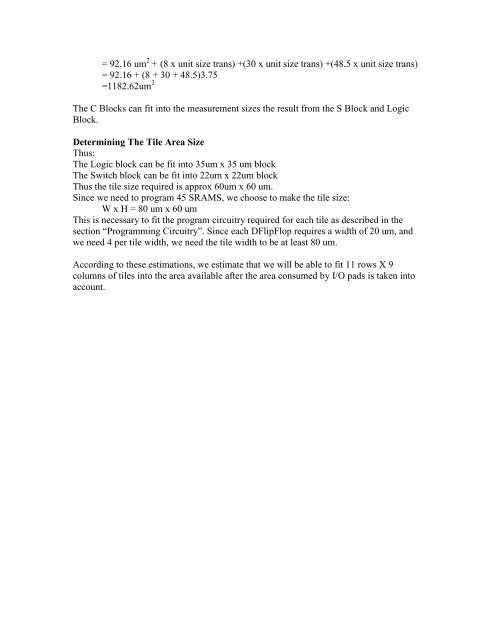Full-Custom Layout of an SRAM-Based FPGA - University of Toronto
Full-Custom Layout of an SRAM-Based FPGA - University of Toronto
Full-Custom Layout of an SRAM-Based FPGA - University of Toronto
Create successful ePaper yourself
Turn your PDF publications into a flip-book with our unique Google optimized e-Paper software.
= 92.16 um 2 + (8 x unit size tr<strong>an</strong>s) +(30 x unit size tr<strong>an</strong>s) +(48.5 x unit size tr<strong>an</strong>s)<br />
= 92.16 + (8 + 30 + 48.5)3.75<br />
=1182.62um 2<br />
The C Blocks c<strong>an</strong> fit into the measurement sizes the result from the S Block <strong>an</strong>d Logic<br />
Block.<br />
Determining The Tile Area Size<br />
Thus:<br />
The Logic block c<strong>an</strong> be fit into 35um x 35 um block<br />
The Switch block c<strong>an</strong> be fit into 22um x 22um block<br />
Thus the tile size required is approx 60um x 60 um.<br />
Since we need to program 45 <strong>SRAM</strong>S, we choose to make the tile size:<br />
W x H = 80 um x 60 um<br />
This is necessary to fit the program circuitry required for each tile as described in the<br />
section “Programming Circuitry”. Since each DFlipFlop requires a width <strong>of</strong> 20 um, <strong>an</strong>d<br />
we need 4 per tile width, we need the tile width to be at least 80 um.<br />
According to these estimations, we estimate that we will be able to fit 11 rows X 9<br />
columns <strong>of</strong> tiles into the area available after the area consumed by I/O pads is taken into<br />
account.














